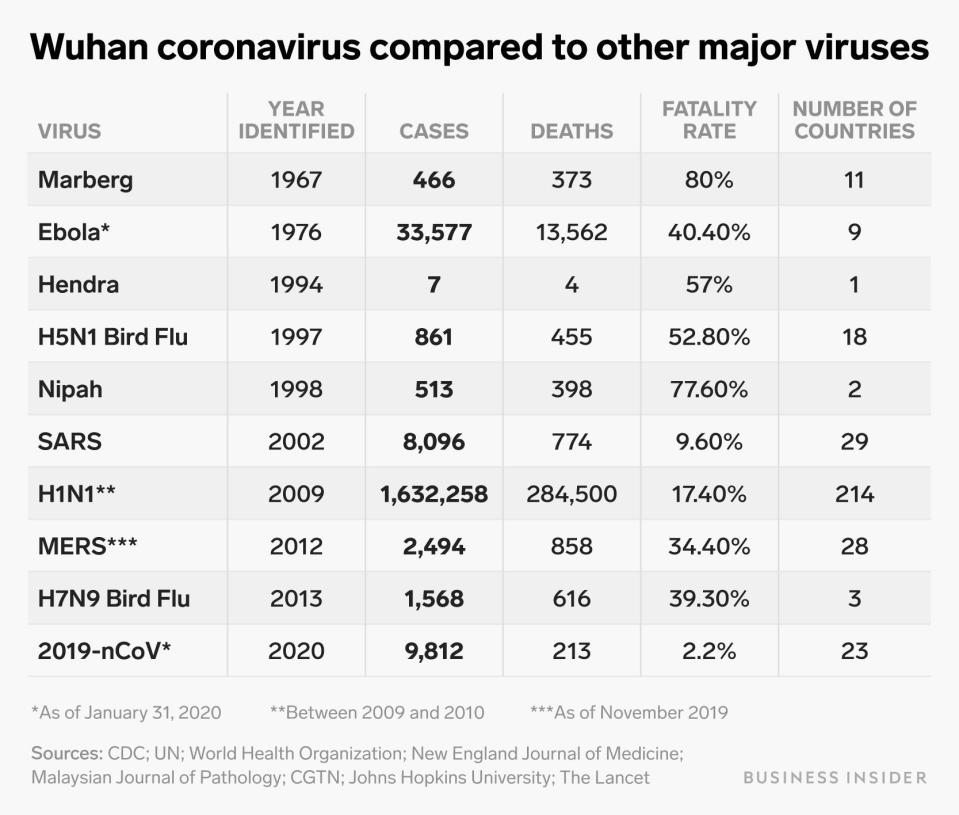One chart shows how the Wuhan coronavirus compares to other major outbreaks and pandemics in the last 50 years

Associated Press
A coronavirus that originated in Wuhan, China, has killed at least 170 people and infected more than 8,000.
Coronaviruses are zoonotic diseases, meaning they can pass from animals to humans. Both this virus and SARS likely originated in bats, then jumped to people.
In the last 50 years, at least 10 infectious diseases have jumped from animals to people.
Here's how the Wuhan coronavirus compares to other major outbreaks.
Since December 31, the Wuhan coronavirus has killed at least 170 people and infected more than 8,000 across 20 countries, including the US.
The outbreak isn't currently considered a pandemic, however, despite its rapid spread. The World Health Organization has not declared it a global public-health emergency either, in part because China has quarantined Wuhan and other nearby cities to stop the virus' spread.
Here's how the Wuhan outbreak compares to other major virus outbreaks in the last 50 years. So far, the coronavirus has the lowest fatality rate.

Shayanne Gal/Business Insider
The chart above does not include mosquito-borne viruses like Zika, malaria, and Dengue fever.
All of these diseases jumped from animals to people
According to experts, the new coronavirus likely originated in bats. More than 75% of emerging diseases originate in animals; these are called zoonotic diseases, meaning they can jump from animals to people. At least 10 outbreaks in the last century have spilled over to humans from mammals like bats, birds, and pigs.
Ebola jumped from fruit bats in west Africa 40 years ago and has killed more than 13,500 people in multiple outbreaks. The Marberg virus, SARS (severe acute respiratory syndrome), MERS (Middle Eastern respiratory syndrome), and Nipah also originated in bats.
The H7N9 and H5N9 bird flus, meanwhile, jumped from infected poultry to people in Chinese markets, together killing more than 1,000 people.

Teh Eng Koon/AFP/Getty
The 2009-2010 swine flu pandemic (also known as H1N1) started, of course, in pigs. It killed nearly 300,000 people in a global pandemic and spread to 214 countries in less than a year.
According to experts, diseases will continue to spill over from animals to humans as the global population grows. The more people there are on Earth, the more our species moves into wild habitats and encounters creatures that harbor viruses.
"Infectious diseases will continue to emerge and re-emerge. I think it's part of the world we live in now," Eric Toner, a senior scientist at the Johns Hopkins Center for Health Security, previously told Business Insider. "We're in an age of epidemics because of globalization, because of encroachment on wild environments."
Read more about the Wuhan coronavirus:
Read the original article on Business Insider

